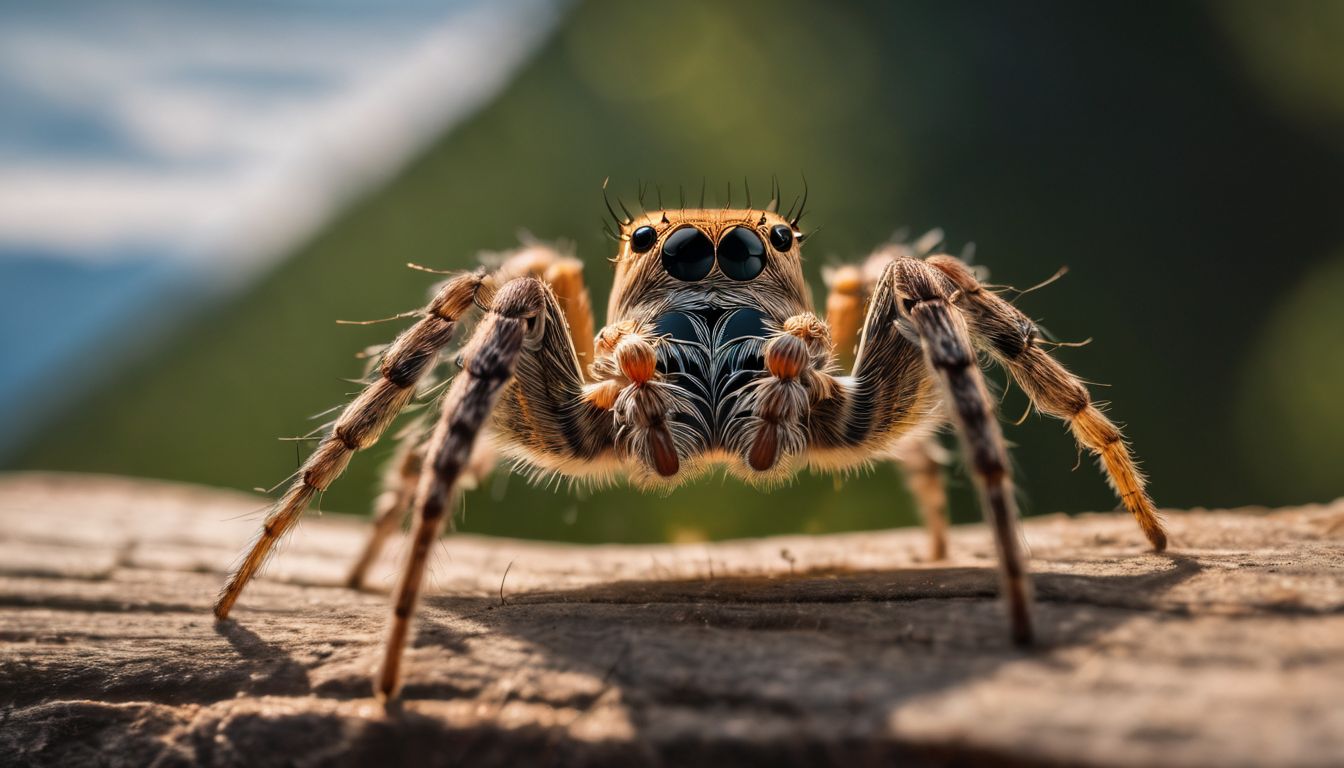Have you ever wondered if spiders can feel pain? While entomologists think spiders lack the receptors for pain, this topic remains a mystery that stirs curiosity. Our article dives into spider biology and behavior to unravel clues about their ability to experience discomfort.
Discover the intriguing world of these eight-legged creatures with us!
Key Takeaways
- The question of whether spiders feel pain remains a mystery, but researchers are exploring the possibility that they may experience some form of discomfort or pain.
- Spiders have a unique nervous system and body structure, which influences how they perceive and respond to potential pain stimuli. They have specialized receptors for sensing damage, such as autotomy for survival without experiencing pain associated with limb loss.
- Observations of spider behavior in potentially painful situations show various responses to injuries and threats, including increased activity levels when shocked, walking away from sources of injury or threat, displaying venomous behavior when provoked, fleeing from perceived danger, and employing autotomization as a survival strategy.
Understanding Pain in Living Organisms

Pain in living organisms can be defined as the subjective experience of unpleasant sensations caused by noxious stimuli, and it is a vital aspect of animal welfare. Animals have specialized receptors and nervous systems that allow them to perceive and respond to pain, prompting ethical considerations for their treatment.
Defining pain
Pain is not just a simple feeling of hurt. It’s a tricky thing that involves both our body and mind. When we talk about pain in living things, it means they feel something bad emotionally and change how they act to avoid getting hurt again or help themselves get better.
It’s important to know that feeling pain is different from just reacting to something harmful like touching a hot stove. True pain has emotions tied up in it, making it very personal and special for each creature that feels it.
Now let’s consider how animals deal with pain.
Pain reception in animals
To go from defining pain, we see that animals can feel and react to things that hurt them. This is called nociception. It means they have special parts in their bodies that sense damage, like when they get cut or burned.
These parts send signals to their brains, telling them something bad is happening.
Many creatures, including bugs and others without backbones, do this too. Researchers are looking at bees, crabs, and even octopuses to learn more about how they deal with pain. Studies show these animals might learn from painful events and could even have feelings like happiness or sadness because of this learning.
It’s important for us to know when an animal might be feeling pain so we can keep them safe and healthy. Since it helps animals stay alive by teaching them what not to do again, the idea that insects could feel pain isn’t so strange after all.
The Spider’s Nervous System and Sensory Experience

The complexity of spider neural structures allows for a variety of sensory experiences and responses. Understanding the nervous system helps shed light on how spiders may perceive and respond to potential pain stimuli.
The complexity of spider neural structures
Spiders have a simple nervous system. Most of their nerves are in the front part of their body, called the cephalothorax. They don’t have a brain like humans or other animals with backbones.
Instead, spiders use clusters of nerve cells to process what they feel and do.
Their bodies are full of tiny sensors that feel touch and movement. These sensors send messages through their nerves to help them know where they are and what is around them. Spiders need these systems to catch food and stay safe from danger, but these systems aren’t made for feelings or pain like ours are.
Autotomy and pain response
Spiders can detach their limbs when threatened, a process called autotomy. Interestingly, this detachment is not necessarily linked to a pain response in spiders like it is in humans.
This unique ability to detach limbs serves as a survival strategy for spiders, allowing them to escape from predators without experiencing the pain associated with limb loss.
Now let’s explore the debate on spider sentience and pain perception.
The Debate on Spider Sentience and Pain Perception
Scientists have differing perspectives on whether spiders experience pain. This section will explore the current understanding of invertebrate pain and the ethical considerations surrounding spider sentience.
Scientific perspectives on invertebrate pain
Invertebrates such as spiders and insects have traditionally been thought not to feel pain. However, ongoing research has challenged this notion. Scientists are now exploring the possibility that these creatures may indeed experience some form of pain, albeit different from what mammals experience.
This understanding is crucial in shaping ethical considerations for our treatment of invertebrates and raising awareness about their welfare.
The debate centers on whether invertebrates possess the neural pathways necessary to process noxious stimuli, leading to behavioral changes that suggest a semblance of discomfort or pain.
This shift in scientific perspectives opens up discussions about the moral and ethical implications related to the treatment of these animals in various contexts, including agriculture and laboratory experiments.
Ethical implications of spider sentience
Understanding the ethical implications of spider sentience is crucial, as it raises questions about how we treat and care for these creatures. The rich inner lives of spiders pose moral dilemmas regarding the treatment and welfare of invertebrate animals as a whole.
As researchers uncover more about the complex neural structures within spiders, it becomes increasingly important to consider their well-being ethically.
The ethical implications of spider sentience prompt us to reevaluate our treatment of all invertebrate animals, challenging some traditional views on animal consciousness and welfare.
Observations of Spider Behavior in Potentially Painful Situations
Observe how spiders respond to injuries and threats, as well as their use of autotomization as a survival strategy. Understand the ways in which spiders adapt to potentially painful situations in their natural environment.
Responses to injuries and threats
Spiders show various responses when they are injured or facing threats. Here are different ways spiders react to such situations:
- Some spiders increase their activity levels when shocked, as a way of responding to a threat.
- Others may choose to walk away from the source of injury or threat instead of engaging with it directly.
- Certain spiders display venomous behavior and could pose a real threat to human health if provoked.
- Spiders have been observed fleeing from what seems like imaginary threats, suggesting that they are capable of perceiving and responding to danger in their environment.
Autotomization as a survival strategy
Spiders have a remarkable ability to sacrifice a limb if it’s caught by a predator, known as autotomy. This is an important survival strategy that helps them escape from dangerous situations.
For example, orb-weaving spiders have been observed to self-amputate legs when stung by venomous insect prey, allowing them to survive and continue hunting for food.
This unique adaptation showcases the incredible ways in which spiders have evolved to protect themselves in their natural environments. Understanding these strategies can shed light on the fascinating world of spider behavior and their methods of survival against potential threats.
Are Zebra Spiders Poisonous? Understanding Spider Defense Mechanisms
Zebra jumping spiders are not aggressive and only bite when they feel threatened. Their bites usually cause redness and pain that lasts less than an hour because of their mild venom.
Wolf spiders also produce venom, but typically, their bites occur in self-defense and are not considered aggressive.
Jumping spiders do have a special way to defend themselves from other predators or threats. If they feel threatened or attacked, they can quickly drop one of their legs to escape the predator’s grasp.
This is called autotomy, which helps them survive and escape from danger without severe harm.Spider bites are generally harmless unless you’re allergic to them.
Conclusion and Considerations for Human Interaction with Spiders
In conclusion, the question of whether spiders feel pain is a complex one. While they may not experience pain in the same way humans do due to their unique nervous system and body structure, ongoing research and debate continue on this topic.
Understanding spider sensation can help us approach human interaction with these creatures more thoughtfully and ethically. As we continue to explore the world of arachnids, it’s essential to consider their sentience and pain perception as part of our interactions with them.
FAQs
1. Do spiders have a way to feel pain?
Spiders can sense things that hurt them because they have sensors called nociceptors, just like many animals do.
2. Can spiders get scared or feel happy like us?
We aren’t sure if spiders can feel emotions like fear or pleasure the same way people do. They react to stuff around them but might not have feelings as we understand them.
3. What does it mean when you say a spider reacts to something painful?
When something harms a spider, it will likely move away or try to protect itself. This response is due to their sensory organs picking up on bad signals, known as noxious stimuli.
4. How do scientists know what insects and spiders sense?
Scientists study how bugs act and use their brains by looking at things like nerve cells and neural networks in model species of insects.
5. Why are some people worried about the pain insects and spiders might feel?
People who care for animal welfare think about if these creatures suffer and how human actions, such as using pesticides or farming meat, affect them.
6. If I don’t want to harm bugs, what could I eat instead of meat?
Some folks choose plant-eating lifestyles like vegetarian or vegan diets to avoid causing harm to animals used in livestock production—even small ones like pollinating insects.




